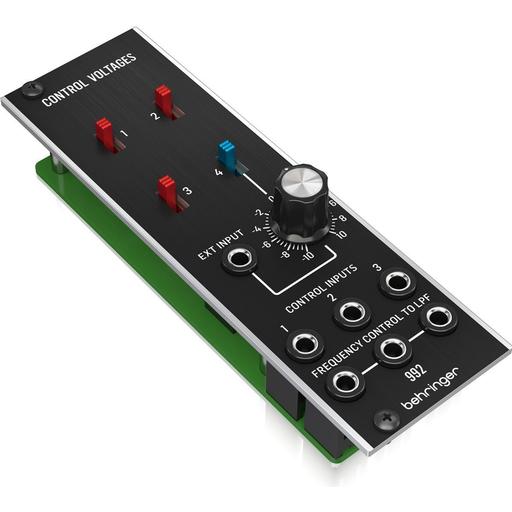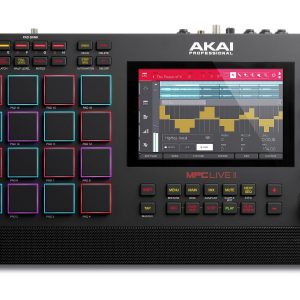Behringer 992 Control Voltages
$27.99
Create and modulate your sound with the Behringer 992 Control Voltages, the perfect tool for any musician looking to expand their sonic palette!
Compare
Description
The Behringer 992 Control Voltages Synthesizer is a versatile and affordable synthesizer module that allows users to manipulate and control various sound and modulation parameters with ease. It’s a perfect addition to any modular synth system and offers plenty of options for sound design and experimentation.
One of the most notable features of the 992 is its ability to generate a wide range of voltages that can be used to control other modules in a modular synth system. The module offers four control voltage generators, each with two inputs and two outputs. These generators can output voltages in the range of -5V to +5V and can be used to control things like oscillators, filters, and envelopes.
Another useful feature of the 992 is its ability to generate trigger and gate signals. The module offers four trigger generators and four gate generators, each with two inputs and two outputs. These signals can be used to trigger envelopes, sequencers, or other modules that respond to trigger or gate signals.
The 992 also includes a sample and hold circuit that allows users to sample an input voltage at a specific rate and hold that voltage until the next trigger or gate signal is received. This can be used to create random modulation patterns or to hold a specific voltage for a particular effect.
In terms of connectivity, the 992 features 3.5mm jacks for all inputs and outputs, making it easy to integrate with other modular synth systems. The module is also compact, measuring only 10 HP in width, which makes it a great choice for those with limited space in their synth racks.
Overall, the Behringer 992 Control Voltages Synthesizer is an excellent module for anyone looking to add some control and modulation options to their modular synth setup. It’s affordable, versatile, and easy to use, making it a great choice for beginners and experienced synth enthusiasts alike.
Behringer 992 Control Voltages properties
| Product name |
Behringer 992 Control Voltages |
| Brand |
Behringer |
| Type |
Synthesizers |
Frequently Asked Questions:
How do the Behringer 992's control voltage inputs function and what external CV sources can be utilized with this feature?
The Behringer 992's control voltage (CV) inputs allow for the external manipulation of various parameters in connected devices. Each channel has two CV inputs, which can be assigned to different functions such as pan, volume, or effects parameters. The CV signals can be generated by a variety of external sources, such as synthesizers, sequencers, or other modular equipment. This feature provides greater flexibility and control over the mixing process, allowing for more complex and dynamic performances.
How does the Behringer 992 interface with external control voltage sources via CV inputs and outputs?
The Behringer 992 audio interface allows for external control voltage (CV) input and output through its dedicated CV ins and outs. These CV ports enable users to incorporate modular synthesizers and other compatible equipment into their digital workflow, providing greater flexibility and creative possibilities in their productions. With support for standard voltages such as +/-5V or +/-10V, the 992's CV functionality is a valuable addition for musicians and producers looking to explore the world of analog synthesis within their DAW environment.
How does the implementation of CV input and output on the Behringer 992 differ from traditional MIDI protocols in regards to synthesizer integration?
The Behringer 992 audio mixer introduces a unique feature in its implementation of CV (Control Voltage) input and output. Unlike traditional MIDI protocols, which primarily control digital synthesizers, the CV inputs and outputs on the 992 are designed to interface with analog synthesizers. This integration allows for greater flexibility in routing audio signals and modulating parameters via voltage control, providing a more hands-on and expressive performance experience for musicians working with classic analog gear.
What are the proper methods for configuring and utilizing Behringer 992 Control Voltages to achieve optimal synthesizer performance?
The Behringer 992 is a versatile mixer that can also be used as a control voltage (CV) source for synthesizers. Here are some steps on how to configure and utilize the 992's CV outputs:
1. Connect your synthesizer(s) to the appropriate inputs on the 992. Make sure you have enough patch cables to connect all of your CV sources to their respective inputs. Turn on both the mixer and the synthesizers. Go through each CV output (LFO, OSC1 VCO, OSC2 VCO, FILTER ENV, etc. This can usually be found in your synthesizer's manual or online resources. For each CV output, adjust the level of the signal using the associated trim potentiometer. Start with a low setting and gradually increase it until you reach the desired amount of modulation. Be careful not to overdrive the input on your synth as this can result in unwanted distortion or instability. If you want to use multiple CV sources at once, consider using a CV mixer module to combine them into a single signal. This allows for more complex modulations and can help prevent overcrowding of patch cables on your synthesizer's inputs. To create rhythmic or sequenced patterns, consider using the 992's built-in LFOs as CV sources. These can be synchronized to an external clock source via the MIDI Clock input, allowing for tight and stable modulation. Experiment with different combinations of CV sources to create unique and interesting sounds. Remember that each synthesizer reacts differently to CV inputs, so it may take some trial and error to find the right settings. Finally, always be mindful of the amount of voltage being applied to your synth's inputs. Too much can cause damage or instability, while too little may not produce enough modulation. A good rule of thumb is to start with small adjustments and gradually increase as needed. By following these steps, you should be able to achieve optimal synthesizer performance using the Behringer 992's CV outputs. Remember to always prioritize safety and proper technique when working with electrical signals.





Reviews
There are no reviews yet.